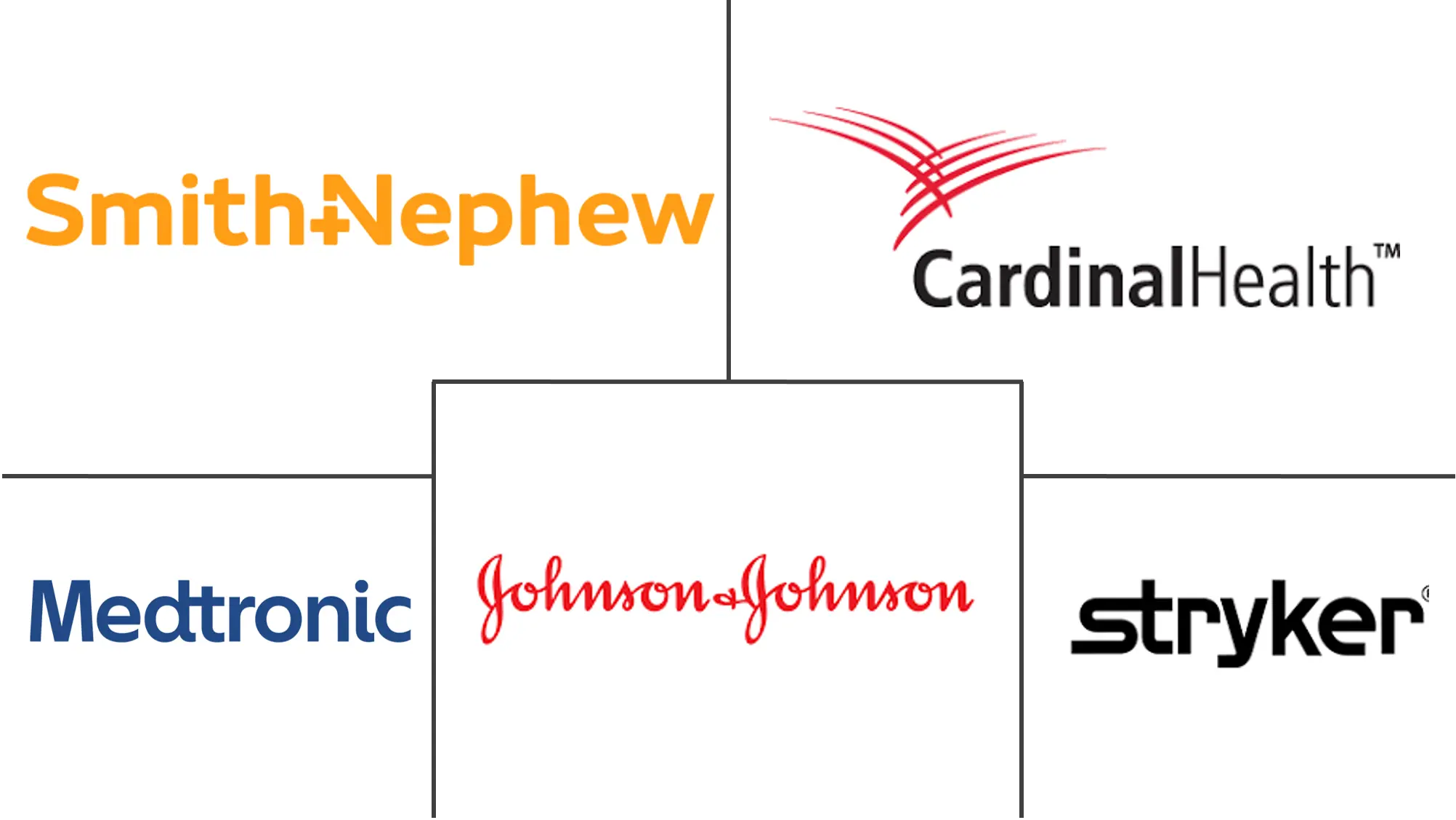Trauma Fixation Devices Market Size and Share
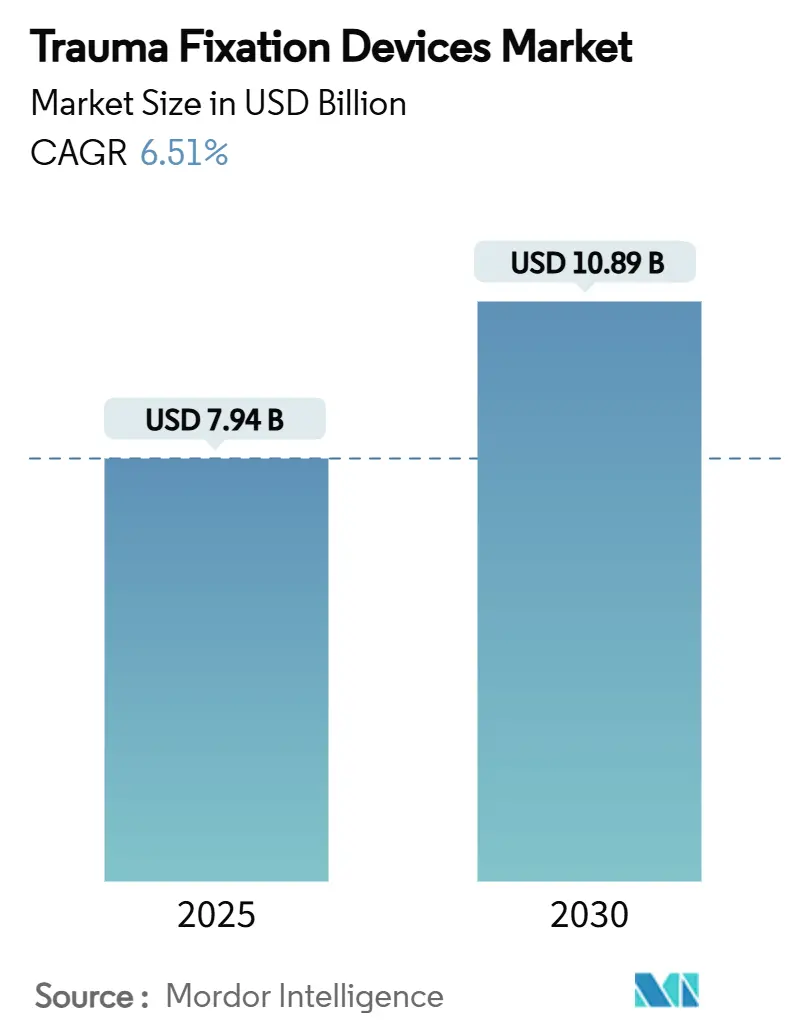
Trauma Fixation Devices Market Analysis by Mordor Intelligence
The trauma fixation devices market size is currently valued at USD 7.94 billion in 2025 and is forecast to reach USD 10.89 billion by 2030, expanding at a 6.51% CAGR over 2025-2030. Internal innovation in bioabsorbable metals, rapid adoption of drug-eluting plates and screws, and the growing preference for outpatient fracture care are the three strongest forces sustaining this momentum. Demographic pressures from osteoporosis, population ageing, and higher accident exposure in urban centers are widening the patient pool, while value-based reimbursement is shifting hospital purchasing toward implants that shorten length of stay and avert secondary removal surgery. Supply-chain risk in titanium and nitinol continues to create margin pressure but is simultaneously nudging manufacturers to explore novel alloy chemistries. Competitive strategies center on 3D-printed patient-specific hardware, antimicrobial coatings, and integrated digital surgery platforms that improve procedural speed and accuracy.
Key Report Takeaways
- By device type, internal fixators held 64.51% of trauma fixation devices market share in 2024 and are projected to grow at an 8.25% CAGR through 2030.
- By surgical site, upper extremities commanded 55.53% of the trauma fixation devices market size in 2024; lower extremities are set to expand at an 8.85% CAGR between 2025-2030.
- By end user, hospitals captured 45.21% revenue in 2024, whereas ambulatory surgery centers will post the fastest 7.87% CAGR to 2030.
- By geography, North America led with a 39.32% slice of the market in 2024; Asia-Pacific is growing fastest at a 7.71% CAGR through 2030.
Global Trauma Fixation Devices Market Trends and Insights
Drivers Impact Analysis
| Driver | (~) % Impact on CAGR Forecast | Geographic Relevance | Impact Timeline |
|---|---|---|---|
| Rising prevalence of osteoporosis | +1.2% | North America & Europe | Long term (≥ 4 years) |
| Increasing road-traffic trauma | +0.8% | Asia-Pacific, spill-over to MEA | Medium term (2-4 years) |
| Growing geriatric population | +1.5% | Global, developed economies | Long term (≥ 4 years) |
| Advances in bioabsorbable materials | +0.9% | North America & EU, expanding to APAC | Medium term (2-4 years) |
| Orthobiologic-enhanced fixation | +0.6% | North America & EU | Short term (≤ 2 years) |
| Modular reusable external fixators in EMs | +0.4% | APAC & MEA emerging markets | Medium term (2-4 years) |
| Source: Mordor Intelligence | |||
Rising Prevalence of Bone-Degenerative Diseases & Osteoporosis
Global osteoporosis affects an estimated 500 million people and is reshaping demand for fixation solutions tailored to compromised bone quality[1]David Oldani, “Epidemiology of Osteoporosis and Fragility Fractures,” Osteoporosis Foundation, osteoporosis.foundation. Fragility fractures now drive hospital admissions that once stemmed from high-energy trauma, prompting device makers to integrate bone-building pharmaceuticals directly into screws and plates. Health systems in the United States incur annual fracture costs above USD 25 billion, forcing payers to fund preventive implants that avert refracture. Manufacturers are therefore racing to validate bioactive constructs that strengthen osseointegration while gradually off-loading stress to healing bone. The trend is most visible in North America and Europe where aging curves are steepest and reimbursement supports premium implants. Over the long term, this driver is expected to add 1.2 percentage points to the trauma fixation devices market CAGR.
Increasing Incidence of Road Traffic Accidents & Trauma Injuries
WHO records show injuries claim 4.4 million lives each year, with Asia-Pacific bearing the heaviest load as motorization outpaces safety infrastructure[2]World Health Organization, “Improving Care of the Injured,” who.int. Expanding urban sports cultures and industrial workplaces add further fracture complexity, demanding modular fixation systems capable of stabilizing multiple bones in a single session. Device makers are introducing integrated platforms that cut operating time and streamline inventory. In medium-term horizons, rising trauma exposure in India, China, and Southeast Asia injects 0.8 percentage points into the projected CAGR for the trauma fixation devices market.
Growing Geriatric Population Vulnerable to Fractures
People aged 65 and older form the fastest-growing trauma cohort, often presenting with comorbidities and polypharmacy that complicate fixation. Minimally invasive plate and nail systems now dominate geriatric protocols by limiting surgical trauma and blood loss. Payers focus on long-term outcomes over device list price, encouraging premium solutions that minimize revision risk. Over the long haul, the aging trend lifts the global trauma fixation devices market by roughly 1.5 percentage points in CAGR contribution.
Technological Advances in Bio-Compatible & Bio-Absorbable Fixation Materials
The 2024 FDA recognition of ASTM F2579-18 accelerated clearances for amorphous PLA and PLGA implants. Bioabsorbable metals, such as Bioretec’s RemeOs magnesium screw, eliminate the need for removal surgery, lowering infection and anesthesia risk. 3D-printing allows surgeons to match implant stiffness and geometry to each patient, while drug-loaded polymers actively promote bone growth. These developments pump an additional 0.9 percentage points into medium-term CAGR.
Restraints Impact Analysis
| Restraint | (~) % Impact on CAGR Forecast | Geographic Relevance | Impact Timeline |
|---|---|---|---|
| High procedure and device costs | -0.7% | Global, strongest in emerging economies | Short term (≤ 2 years) |
| Time-consuming regulatory approvals | -0.5% | North America & EU | Medium term (2-4 years) |
| Supply-chain shortages in Ti & nitinol | -0.4% | Global, high-volume manufacturers | Short term (≤ 2 years) |
| Multidrug-resistant implant infections | -0.6% | Global, hospital settings | Medium term (2-4 years) |
| Source: Mordor Intelligence | |||
High Procedure & Device Costs
Premium bioabsorbable and drug-eluting implants cost more up front, limiting uptake in lower-income settings. Bundled payments push hospitals and ambulatory centers to scrutinize total episode cost, often opting for modular systems that stretch inventory budgets. This cost friction shaves 0.7 percentage points off short-term trauma fixation devices market growth.
Rising Implant-Associated MDR-Infection Concerns
Biofilm-linked infections affect roughly 5% of orthopedic operations and can necessitate implant removal, extending hospital stays and raising litigation risk. XDR Klebsiella pneumoniae and MRSA outbreaks underscore the threat. Regulatory scrutiny of antimicrobial coatings remains stringent, delaying product launches. Combined, these pressures subtract 0.6 percentage points from medium-term CAGR.
Segment Analysis
By Device Type: Internal Fixators Sustain Leadership Through Absorbable Metal Adoption
Internal fixators generated 64.51% of trauma fixation devices market share in 2024, while their sub-segment is set to log an 8.25% CAGR to 2030, the fastest across all device categories. The trauma fixation devices market size attributed to internal fixators will thus outpace overall industry expansion as bioabsorbable screws gain traction in pediatrics and geriatrics. Plates equipped with dynamic compression slots permit controlled micromotion that encourages callus formation; Zimmer Biomet’s MotionLoc screw exemplifies this capability[3]Zimmer Biomet, “MotionLoc Screw Technology,” zimmerbiomet.com.
The advent of smart alloys and modular tray layouts lets surgeons adjust construct stiffness intraoperatively, cutting inventory by up to 30%. Drug-eluting coatings further differentiate internal hardware by merging mechanical support with biologic therapy. External fixators remain indispensable for complex open fractures and damage-control orthopedics, yet reimbursement pressures drive interest toward reusable frame kits that lower per-case expenditure. Together, these trends keep internal solutions ahead but invite continuous innovation to protect share.
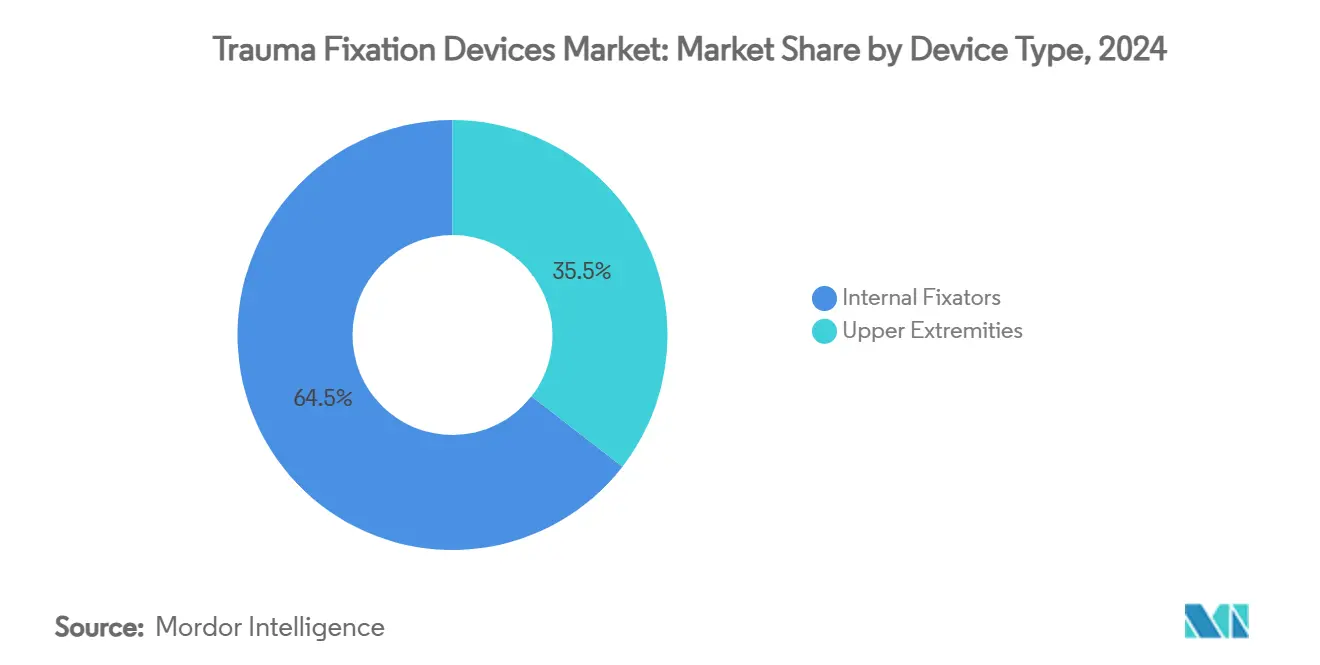
By Surgical Site: Upper Extremity Dominance Meets Lower Extremity Surge
Upper extremity procedures accounted for 55.53% of the trauma fixation devices market in 2024 owing to persistent wrist and shoulder injuries in sports, work, and domestic falls. Variable-angle plates that contour to distal radius anatomy reduce tendon irritation, making them a staple in day-care surgery. Conversely, lower extremity demand is accelerating at 8.85% CAGR to 2030 as pelvic and hip fracture volumes rise in osteoporotic patients. The trauma fixation devices market size tied to lower extremity implants is projected to close the gap on upper limb usage over the next decade.
Innovations such as percutaneous hollow screws for pubic symphysis fractures allow elderly patients to avoid open surgery, shortening rehab times. Robotic navigation in spine trauma further streamlines screw placement accuracy, cutting revision risk. Collectively, evolving lower limb techniques invite manufacturers to tailor product lines to geriatric bone biology and complex pelvic geometry.
By End User: Ambulatory Surgery Centers Capture Outpatient Momentum
Hospitals retained a 45.21% revenue share in 2024, driven by complex polytrauma and revision workloads. However, ambulatory surgery centers (ASCs) are projected to post the highest 7.87% CAGR through 2030, fueled by minimally invasive protocols that allow same-day discharge. Procedures migrating to ASCs include distal radius plating and clavicle fracture fixation, which traditionally required inpatient monitoring.
Enhanced regional anesthesia, rapid-recover implants, and remote patient-monitoring apps underpin the shift. The trauma fixation devices market now witnesses manufacturers bundling implant kits with disposable drapes, single-use power tools, and cloud-based navigation support suited to ASC economics. Specialty orthopedic clinics and emergency centers also broaden implant consumption, yet ASCs remain the prime outpatient growth engine across developed and developing regions alike.
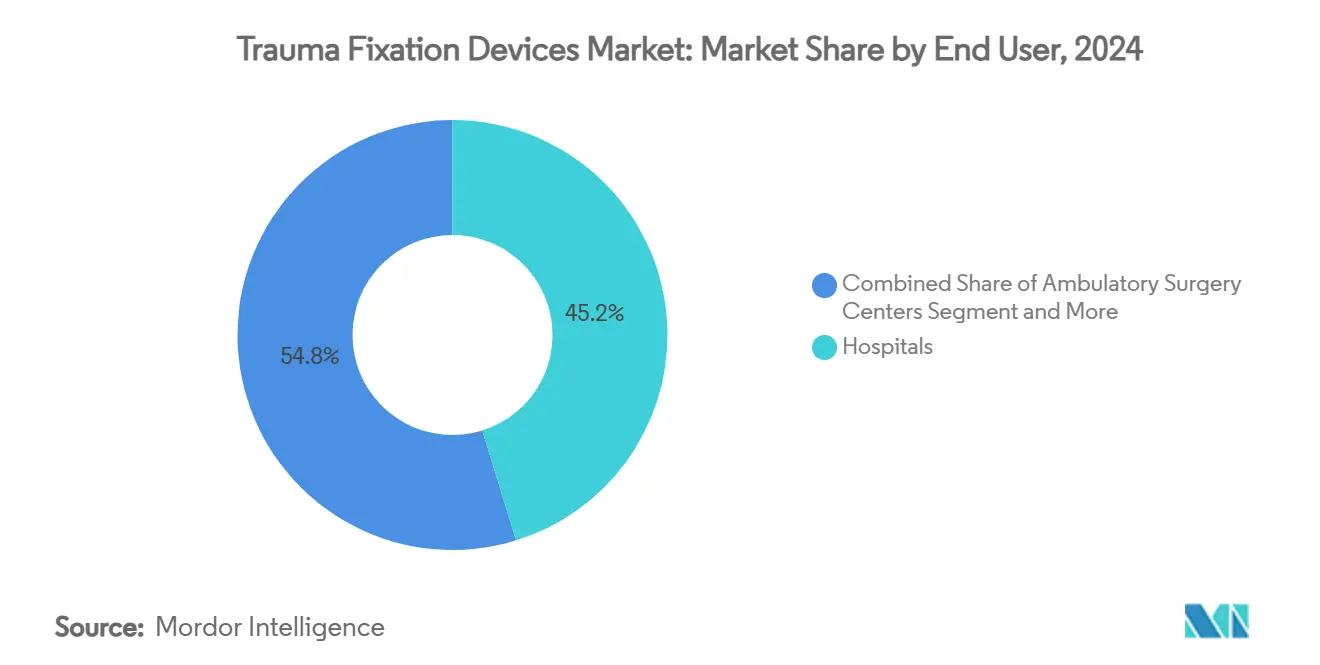
Note: Segment shares of all individual segments available upon report purchase
Geography Analysis
North America controlled 39.32% of global revenue in 2024 and will maintain its lead through 2030 on the back of robust reimbursement and high surgical skill density. The November 2024 FDA guidance for bone plates and screws has sharpened review criteria yet also clarified pathways, shortening approval cycles for digital-ready implants. United States payers actively fund bioabsorbable implants to dodge secondary surgery, while Canadian hospitals invest in robotics aimed at smaller incisions and quicker turnover.
Asia-Pacific is forecast to clock the fastest 7.71% CAGR over 2025-2030 as healthcare systems expand orthopedic theaters and trauma centers. China and India witness rapid trauma growth tied to urban transportation and construction, prompting procurement of versatile modular fixators. Japan’s super-aged society pushes geriatric-specific nailing systems, whereas South Korea pioneers AI-driven fracture planning. Domestic OEMs in China are entering global supply chains for titanium plates, adding competitive heat.
Europe remains a stable third pillar, buffered by tight CE-Mark scrutiny and strong clinician–industry collaboration. Germany and the United Kingdom spearhead biodegradable implant trials aligned with environmental directives. Southern European markets accelerate adoption of reuse-optimized external fixators to curb spending. In Central-Eastern Europe, EU structural funds upgrade trauma units, giving multinationals fresh tenders.
The Middle East and Africa, alongside South America, collectively offer mid-single-digit expansion as governments channel oil proceeds and recovery funds into tertiary hospitals. Gulf states buy premium navigation-enabled systems, whereas Sub-Saharan Africa leans on donor-funded fracture programs that seek reusable ex-fix frames. Across Latin America, Brazil’s public health service increasingly reimburses drug-eluting plates for diabetic foot fracture prevention, nudging regional procurement norms higher.
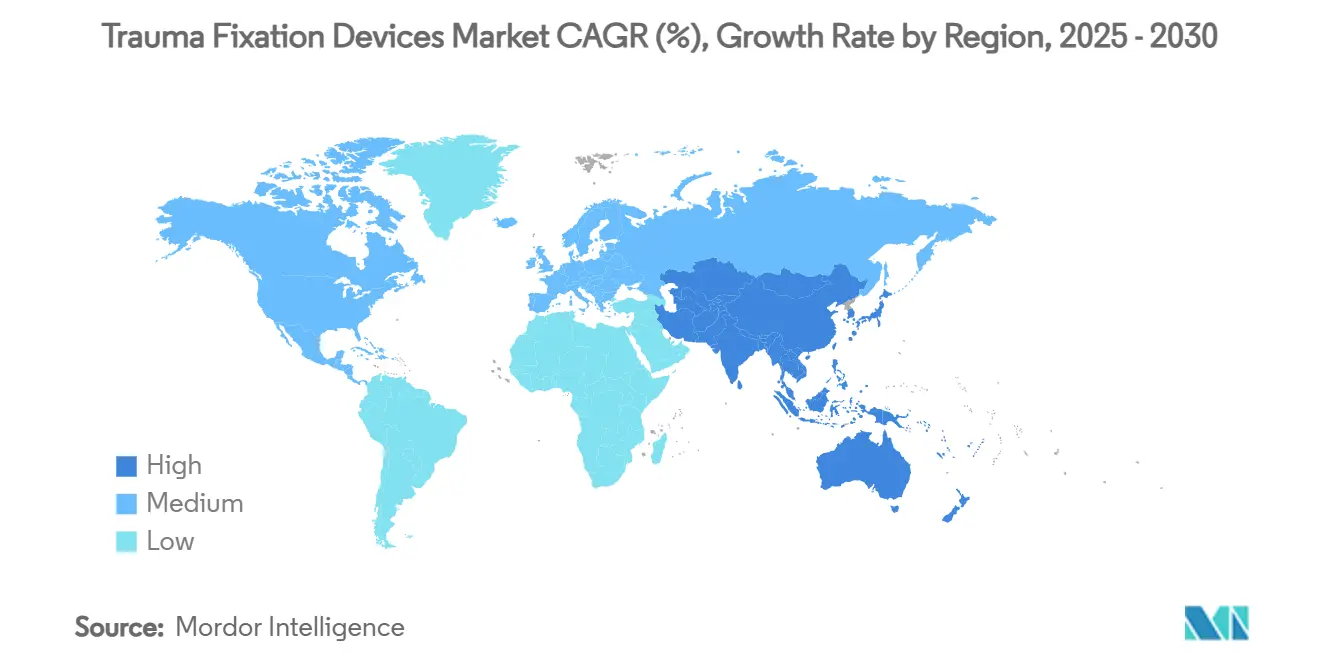
Competitive Landscape
The trauma fixation devices market is moderately consolidated. Stryker, DePuy Synthes, and Smith & Nephew collectively have significant revenue share, leveraging broad catalogs and digital surgery platforms. Stryker’s Blueprint Mixed Reality Guidance System overlays 3D imaging in real time, improving implant placement while feeding analytics back into product R&D. Zimmer Biomet deploys MotionLoc screws to retain compression yet allow controlled motion, differentiating hip and shoulder constructs.
Midsize challengers attack niche gaps. Bioretec secured first-in-class FDA clearance for its RemeOs magnesium screw in 2024, validating absorbable metal technology previously limited to Europe. Enovis strengthened its extremity lineup via the January 2024 acquisition of LimaCorporate, adding porous Trabecular Titanium and 3D-printed lattice architectures. Orthofix Medical extended external fixation capability with the TrueLok Elevate transverse bone transport system cleared in March 2025, targeting diabetic foot ulcer limb salvage.
Strategic themes include platform ecosystems bundling hardware, software, and AI navigation; expansion into bioactive coatings; and supply-chain localization for metal raw materials. Larger players recruit digital talent, partner with image-guided surgery start-ups, and sign multi-year value-based pricing deals with hospital systems. Smaller disruptors focus on single-use, pre-sterile kits for ASCs and biodegradable alloys for pediatrics, accelerating innovation cycles.
Trauma Fixation Devices Industry Leaders
-
Medtronic PLC
-
Stryker Corporation
-
Cardinal Health Inc.
-
Smith & Nephew PLC
-
Johnson & Johnson (DePuy Synthes)
- *Disclaimer: Major Players sorted in no particular order
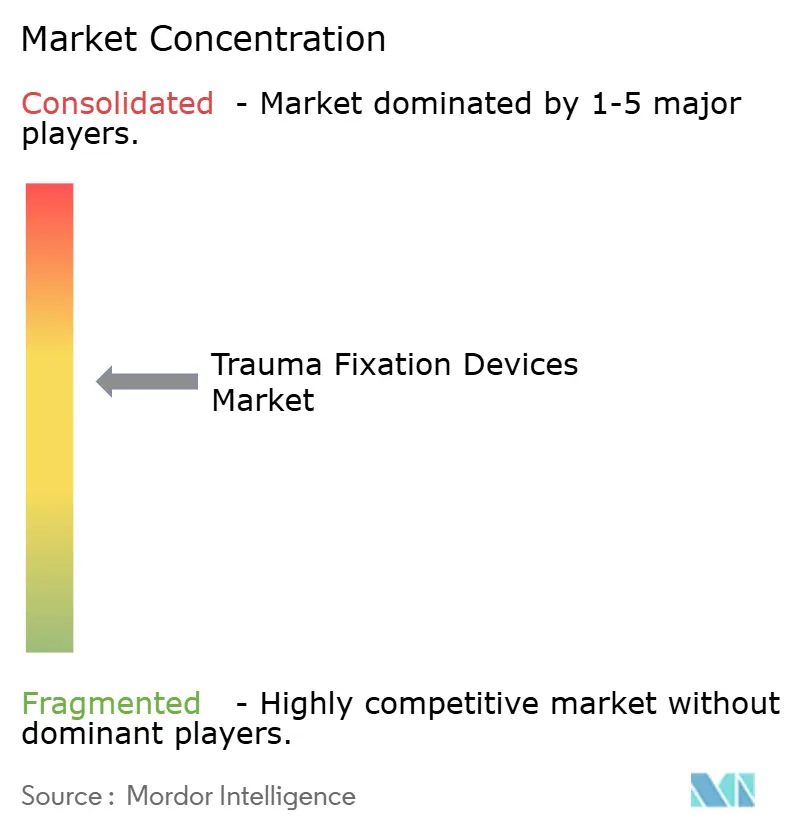
Recent Industry Developments
- March 2025: Orthofix Medical received FDA 510(k) clearance and CE Mark for the TrueLok Elevate Transverse Bone Transport System, the first dedicated TBT device cleared for limb preservation and diabetic foot ulcer care.
- March 2025: Johnson & Johnson MedTech unveiled the VOLT Plating System at AAOS 2025, combining dynamic compression with variable-angle locking to serve the 1.7 billion-strong musculoskeletal patient pool.
Global Trauma Fixation Devices Market Report Scope
As per the scope of the report, trauma is a physical injury that includes burns, fractures, sprains, strains, etc., caused by any external source (fire and accident). The Centers for Disease Control and Prevention (CDC) has defined trauma as 'an injury or wound to a living body caused by the application of external force or violence'. The trauma fixation devices market is segmented by type (internal (plates, screws, nails, and others) and external fixators (unilateral and bilateral external fixators, circular fixators, and hybrid fixators), surgical site (lower extremities (hip and pelvic, foot and ankle, knee, and others) and upper extremities (hand and wrist, shoulder, spine, and others), end user (hospitals, ambulatory surgery centers, and other end users), and geography (North America, Europe, Asia-Pacific, Middle East and Africa, and South America). The report offers the value (in USD million) for the above segments.
| Internal Fixators | Plates |
| Screws | |
| Nails | |
| Others | |
| External Fixators | Unilateral & Bilateral Fixators |
| Circular Fixators | |
| Hybrid Fixators |
| Lower Extremities | Hip & Pelvic |
| Foot & Ankle | |
| Knee | |
| Others | |
| Upper Extremities | Hand & Wrist |
| Shoulder | |
| Spine | |
| Others |
| Hospitals |
| Ambulatory Surgery Centers |
| Other End Users |
| North America | United States |
| Canada | |
| Mexico | |
| Europe | Germany |
| United Kingdom | |
| France | |
| Italy | |
| Spain | |
| Rest of Europe | |
| Asia-Pacific | China |
| Japan | |
| India | |
| South Korea | |
| Australia | |
| Rest of Asia-Pacific | |
| Middle East and Africa | GCC |
| South Africa | |
| Rest of Middle East and Africa | |
| South America | Brazil |
| Argentina | |
| Rest of South America |
| By Device Type | Internal Fixators | Plates |
| Screws | ||
| Nails | ||
| Others | ||
| External Fixators | Unilateral & Bilateral Fixators | |
| Circular Fixators | ||
| Hybrid Fixators | ||
| By Surgical Site | Lower Extremities | Hip & Pelvic |
| Foot & Ankle | ||
| Knee | ||
| Others | ||
| Upper Extremities | Hand & Wrist | |
| Shoulder | ||
| Spine | ||
| Others | ||
| By End User | Hospitals | |
| Ambulatory Surgery Centers | ||
| Other End Users | ||
| Geography | North America | United States |
| Canada | ||
| Mexico | ||
| Europe | Germany | |
| United Kingdom | ||
| France | ||
| Italy | ||
| Spain | ||
| Rest of Europe | ||
| Asia-Pacific | China | |
| Japan | ||
| India | ||
| South Korea | ||
| Australia | ||
| Rest of Asia-Pacific | ||
| Middle East and Africa | GCC | |
| South Africa | ||
| Rest of Middle East and Africa | ||
| South America | Brazil | |
| Argentina | ||
| Rest of South America | ||
Key Questions Answered in the Report
What is the current value of the trauma fixation devices market?
The trauma fixation devices market size stands at USD 7.94 billion in 2025 and is projected to grow to USD 10.89 billion by 2030.
Which device category holds the largest share?
Internal fixators lead with 64.51% global trauma fixation devices market share in 2024.
Why are ambulatory surgery centers important for future growth?
ASCs combine minimally invasive techniques and lower facility overheads, enabling trauma procedures to shift outpatient and helping the segment log a 7.87% CAGR through 2030.
What technological trends will shape next-generation implants?
Bioabsorbable metals, drug-eluting coatings, 3D-printed patient-specific hardware, and mixed-reality surgical navigation rank as the most influential innovations.
How are regulatory changes affecting new product launches?
Clearer FDA guidance on bone-plate submissions and recognized standards for bioabsorbable resins have shortened approval timelines, although combination devices with antimicrobial agents still face rigorous review.
Page last updated on:
